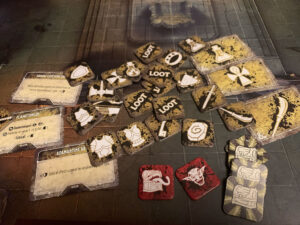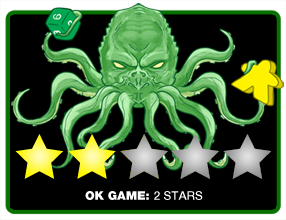 I started playing the Moldvay-era basic Dungeons and Dragons red and blue box and have played D&D off and on through the release of 5th edition as well as many of the gold box and other video games. My love of fantasy dungeon crawlers can be traced back to D&D. I’m also a fan of tactical skirmish games so I was pretty excited to get the opportunity to review D&D Onslaught.
I started playing the Moldvay-era basic Dungeons and Dragons red and blue box and have played D&D off and on through the release of 5th edition as well as many of the gold box and other video games. My love of fantasy dungeon crawlers can be traced back to D&D. I’m also a fan of tactical skirmish games so I was pretty excited to get the opportunity to review D&D Onslaught.
D&D Onslaught seems to be Wizkids’ D&D-branded foray into tactical skirmish games like Kill Team, Warcry, and Heroscape. And much like OG Heroscape, Onslaught comes with pre-painted miniatures. So how does this two-player game measure up to other skirmish games?
Gameplay Overview:
After picking characters from each of the two included teams (there are expansions with more teams) and setting up their characters per the scenario instructions, one player will take the initiative card with a 1 on it and then deal the other five cards numbered 2 through 6 out with their opponent getting three of those cards. For skirmishes with more than three heroes, a second set of four cards (numbers 7 through 10) are shuffled and dealt out. Each player assigns an initiative order to each of their heroes. Enemy figures have an automatic value of X.5 (5.5, 3.5, etc.) which makes it very clear when they activate.

On each character’s turn, they can take a move action, a standard action, a bonus action, and all the free actions they can freely take for free. Standard actions can also be turned into move or bonus actions allowing for faster travel around the board and movement actions can be turned into bonus actions. There are also some special abilities that use two types of actions.
Movement is only orthogonal, and any hindering terrain or elevation changes take one additional point of movement to move through.
The combat system is d20 based, like Dungeons and Dragons, except you’ll generally roll two 20-sided dice and take the better of the two rolls, unless you roll a 1 which is an automatic miss. It’s basically like having permanent advantage. If the target has cover or some other effect, you only get to roll one attack die.

Damage is usually between one and three with critical hits granting an additional point of damage or two and sometimes a special effect based on the weapon or the character.
Each character has a board that tracks cooldowns for abilities, various stats, and Experience. Every five experience points, each character can learn a new skill (choosing from two for each character). Experience is earned from looting boxes, dealing damage to an opponent, and by some class-specific requirements like defeating a character, being attacked, etc.).
Scenarios last a set number of rounds unless other victory conditions are met.

Game Experience:
The game captures a lot of the fifth edition feel of Dungeons and Dragons but distilled down for balance and faster play. The simplified movement rules are a great example of adding depth to a skirmish without making things unnecessarily complicated (*glares at Batman Gotham City Chronicles*).
In terms of the combat itself, the game is also quasi-streamlined with characters having basic melee and/or ranged attacks, and then a few special abilities. But with many characters getting a free parting shot at anyone moving away from them (called an attack of opportunity) several clashes turned into smacking each other until someone died. When someone can break away or place a status such as stunned, slowed, or dazed, then the tactical elements shine a bit more. However, while it’s trying to be streamlined, each player is also managing five different player boards with unique rules and five dials on each one which makes it easy to miss something and a little more challenging to grasp out of the box.

The game isn’t quite a straight-up PvP brawler as there are also enemies that, if not dealt with, could play whack-a-gnome on your character (assuming you have a gnome on your team) as well as complete scenario-based objectives. These add some variety and with expansion packs, I could easily see this game expanding with a lot of scenarios being added over time by leveraging the vast menagerie of monsters in the D&D library.
Deciphering the iconography, which is tiny for your inconvenience, and learning how to use and maximize your abilities is important. Many of the cooldowns are three to five turns so you may only get to use some of your big abilities once or twice in a game so knowing when to use abilities or save them for later can make a difference. Additionally, characters can gain loot tokens from treasure chests which are magic items that will be familiar to many D&D players. These items will give additional benefits such as a new type of attack, increasing defense, or healing wounds.

Ultimately level design matters as much as the mechanics and some of the scenario designs can be lacking. For example, in scenario two you can gain victory points for various things but whoever rescues their prisoner first wins, essentially negating everything else done during the scenario which turned it into a non-sensical race with limited interactions between teams. Another scenario could end up with a runaway leader without a way of mercifully ending the game. That one was fun until my opponent realized they couldn’t win with two rounds to go. There’s both a campaign mode with seven scenarios as well as three one-shot skirmishes.
At Board Game Quest we often gloss over component quality but with the price point on this one, I think it deserves some digital ink. For transparency, WizKids provided the base game and two separate faction expansion boxes for review but as I compare the Onslaught core set to other games I’ve purchased I feel like the bang for the buck is limited between the quantity and quality of the components. Outside of the pre-painted miniatures, Onslaught feels cheap. The worst offenders are the token draw “bag,” which is a logo-embossed Tyvek envelope, and the dashboards, which are really thin cardboard. Besides being thin, some of the symbols on the dashboards didn’t line up with cutouts very well and a few of the dial pegs kept popping out.
Final Thoughts:
I found D&D Onslaught to be an okay skirmish game with relatively poor-quality components at a premium price point. Where I see this set having the most value is with D&D players who also plan to use the miniatures and/or the boards in their RPGs. As a skirmish game, it’s too complicated for players looking for a streamlined experience but doesn’t offer enough interesting decisions to satisfy the more advanced gamers. There’s minimal team construction (pick five of six heroes for your team and go) which makes it inferior to Heroscape with more fiddliness to manage five unique characters. As someone who loves fantasy, I had some fun but it’s not going to displace Fireteam or Sorcerer’s Arena from my collection as a go-to skirmish game.
Final Score: 2 Stars – D&D Onslaught is an okay D&D-skinned skirmish game with some neat ideas but ultimately doesn’t distinguish itself in a crowded market.
 Hits
Hits
• Initiative and movement systems are clean
• Pre-painted minis look better than gray plastic
• Familiar D&D monsters, items, and lore abound
Misses
• Too simple to be satisfying and too many things to manage to be gateway friendly
• Some scenario design was lacking
• Components generally felt/looked cheap
Source: Board Game Quest




